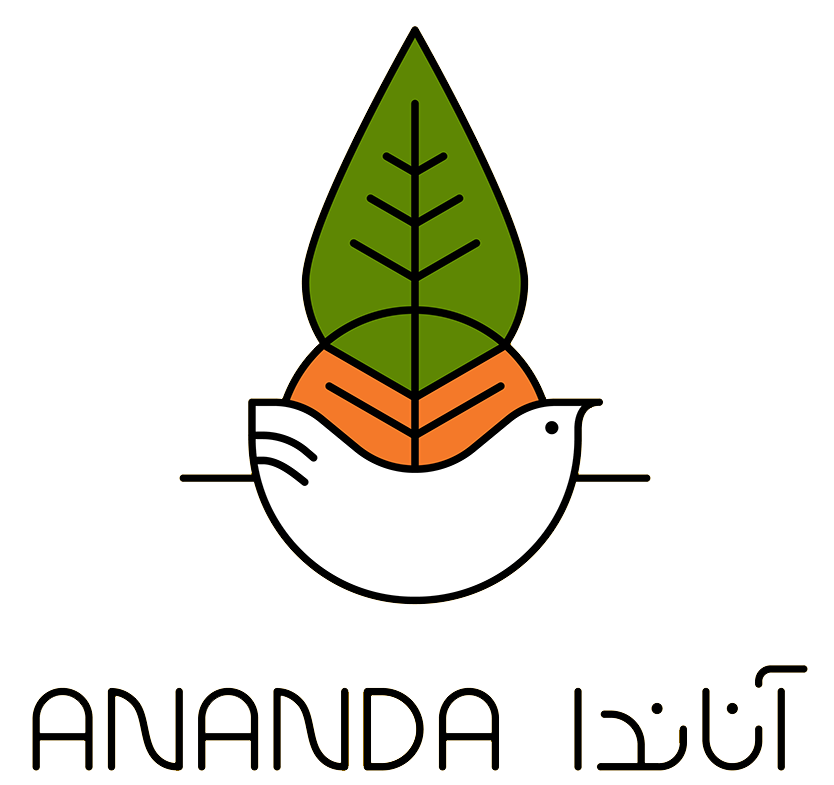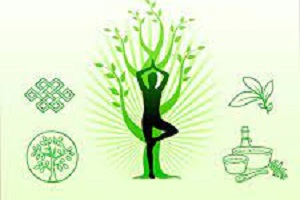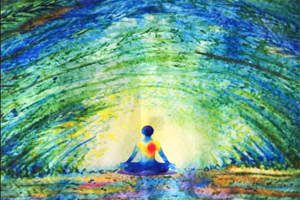By Setareh Kiumarsi
Hello, beautiful souls! Have you ever come across the word Ayuryoga?
This word is a combination of Ayurveda and Yoga—two sciences that are like inseparable companions… like two sisters… or as Mukunda Stiles beautifully puts it, their interconnection is as inseparable as the body’s relationship with breath, or the way a plant’s roots merge with the soil.
But why is it so important to honor the deep relationship between these two disciplines when walking the path toward lasting balance of body and mind—and to use both of them together?
Imagine two bowls:
One is filled with spicy Mexican or Indian food bursting with chili, and the other is a bowl of Caesar salad full of lettuce and cucumber. When you eat from the first bowl, your mouth feels fiery and your body fills with heat; when you eat from the second, your mouth cools down and your body absorbs a refreshing quality of coldness.
In other words, every food we eat carries certain qualities—some are warm, some cool; some dry, some moist.
Yoga
Now let’s move on to the world of Yoga. You’ve probably heard that there are certain points in the body that carry our vital energy. Stimulating each of these points affects specific organs in the body and changes their qualities of heat, cold, dryness, or moisture.
In Ayurveda, these are called Marma points—the same points that are stimulated with needles in Chinese medicine.
Yoga asanas (postures) are designed so that with every movement, some of these points contract and others expand. Through this contraction and expansion, the internal organs connected to those points are stimulated, and qualitative changes take place within them.
In other words, asanas—just like foods—affect the body’s qualities. Some increase warmth, others coolness; some create dryness and lightness, while others increase moisture and heaviness.
So, with that in mind—do you think every asana is good for everyone?
Imagine one person has a cold constitution, a slow metabolism, hypothyroidism, and excess moisture in the body; another person is very thin, with a fast metabolism, hyperthyroidism, and excess heat and dryness. Do you think a warm and dry asana would be healing for both of them? Or might it be medicine for one and poison for the other?
The purpose of writing about this vast subject is first and foremost to spark your awareness. Remember: not every asana, simply because it belongs to the beautiful discipline of Yoga, is automatically healing for you—it can actually be harmful if used incorrectly. But if you understand your constitution (dosha) and use Yoga intelligently, it’s as though you’re visiting a master acupuncturist every day. In many cases, what a well-balanced Yoga sequence can do to restore harmony in your body is something even a strong medicine cannot achieve.
In the upcoming posts, I’ll take you gently into the intertwined world of Yoga and Ayurveda. In the first step, we’ll dive into the ocean of Ayurveda and get familiar with its core concepts—such as the doshas (Vata, Pitta, and Kapha), Prakriti, and Vikriti. Then, we’ll step into the world of Yoga to explore which asanas are suitable for each dosha.
What does Ayurveda mean…?
In the previous post, we talked a little about the concept of Ayuryoga. Before diving deeper into the details, we agreed to first take a gentle dive into the vast ocean of Ayurveda — to get familiar with its foundational concepts such as the doshas (Vata, Pitta, and Kapha), Prakriti, Vikriti, and more — and then move on to the relationship between the doshas and yoga asanas.
Ayurveda, or traditional Indian medicine, has a history of over 5,000 years. The word Ayurveda is composed of two Sanskrit words: Ayur, meaning life, and Veda, meaning knowledge or science. So, Ayurveda translates to “the science of life” — the art of living well and maintaining a lasting balance between body and mind.
Everything that exists in nature, humans, animals, plants, food, objects, and beyond, is made up of a unique combination of five fundamental elements: ether, air, fire, water, and earth.
The Five Elements
The first element is ether (Akash in Sanskrit); cold, dry, empty, and light. It’s like a vast open ocean that holds everything within it. In nature, think of the space in the air. In your body, think of the emptiness in your digestive tract when you’re hungry, or the hollow spaces in your mouth, nose, and lungs.
The second element is air (Vayu). It’s cold, dry, light, mobile, and rough; its most important quality is movement. It not only moves on its own but also sets everything around it in motion. In nature, think of the wind blowing. In your body, think of the gases in your stomach and intestines, or the air flowing in and out of your lungs.
The third element is fire (Agni). It’s hot, dry, sharp, and penetrating. In nature, think of the sun, sunlight, or the flame of fire. In your body, think of bile, stomach acid, and digestive enzymes.
The fourth element is water (Apas). It’s cold, moist, oily, smooth, and cohesive. In nature, think of rain, springs, and the sea. In your body, it’s represented by saliva, mucus, urine, plasma, and all the bodily fluids.
The fifth element is earth (Pruthvi). It’s cold, dry, dense, stable, and heavy; the source of structure and solidity. In nature, think of sand, rocks, mountains, and soil. In your body, it’s found in minerals that form bones, cartilage, nails, and teeth.
The Doshas
In Ayurveda, these five elements are grouped into three main life forces, or doshas: Vata, Pitta, and Kapha.
Vata is composed of ether and air. It’s cold, dry, light, subtle, rough, and mobile — and movement is its defining quality. All vital bodily functions involve motion: downward movement in urination, defecation, and menstruation; circulatory movement of blood; inhalation and exhalation of air; and joint movement. Vata acts as a carrier and is responsible for all bodily motion.
Pitta is composed of fire and water. It’s hot, sharp, oily, and fluid. Pitta governs metabolism and plays a key role in digestion and nutrient absorption at the cellular level.
Kapha is composed of water and earth. It’s cold, moist, heavy, oily, dense, and cohesive. Kapha is responsible for growth, lubrication, and structural integrity. The water element maintains moisture in tissues, while the earth element gives the body strength and stability.
Prakriti and Vikriti
Imagine each dosha as a container filled with specific qualities, strengths, weaknesses, and tendencies — both physical and mental. Every individual is born with a unique combination of these three doshas. This combination determines their constitution or Prakriti, their inherent nature. In Ayurveda, a person learns how to live and eat according to their Prakriti to maintain harmony and sustainable balance.
Generally, seven types of Prakriti are recognized:
• Vata-dominant: Vata is much stronger than Pitta and Kapha.
• Pitta-dominant: Pitta is much stronger than Vata and Kapha.
• Kapha-dominant: Kapha is much stronger than Vata and Pitta.
• Vata-Pitta (or Pitta-Vata): Both Vata and Pitta are high; Kapha is low.
• Pitta-Kapha (or Kapha-Pitta): Both Pitta and Kapha are high; Vata is low.
• Vata-Kapha (or Kapha-Vata): Both Vata and Kapha are high; Pitta is low.
• Vata-Pitta-Kapha (Tridoshic): All three doshas are relatively balanced.
Each constitution brings specific physical and emotional characteristics. You can visit www.ananda.ir and take Ananda’s dosha test to better understand your Prakriti, or natural constitution.
Many internal and external factors influence the balance of the doshas: diet, lifestyle, sleep patterns, seasons, location, thoughts, emotions, and age. These factors can either keep the doshas in balance or push them out of alignment. Your current doshic state — as influenced by these factors — is called Vikriti. By harmonizing Prakriti (your natural constitution) with Vikriti (your current state), you can experience true well-being.
If you have time, explore the educational resources on Ananda’s website to deepen your understanding of the doshas and your unique body-mind type.
As mentioned before, in Ayurveda, the human body and mind are explained through three main categories called doshas: Vata, Pitta, and Kapha.
Vata is the first dosha — composed mainly of ether and air. It is cold, dry, light, subtle, rough, and mobile. Movement is its most defining quality. All vital bodily functions involve movement — the downward flow during urination, defecation, and menstruation; the circulation of blood; the inhalation and exhalation of breath; the beating of the heart; blinking of the eyes; the motion of joints and muscles; and even the flow of thoughts in the mind. The Sanskrit root of Vata means carrier or mover, representing its function as the vital force of motion within the body.
In some people, Vata is naturally dominant and forms their primary constitution or Prakriti. In others, an imbalanced lifestyle or improper diet can cause Vata to go out of balance. Generally, when Ayurveda speaks of a dosha being out of balance, it means that the elements and qualities associated with that dosha have increased beyond their natural proportion. Excess Vata means an excess of ether and air — thus an excess of coldness and dryness — within both body and mind. Among the three doshas, Vata is the most likely to fall out of balance.
Physical Characteristics of Vata Types
• Vata-dominant individuals are typically slim and light. Because ether and air are dominant in their makeup, their bodies have less density and gain weight with difficulty.
• Their height tends to be either quite tall or quite short.
• Their skin is cold, dry, rough, and often cracked.
• Their faces are lean, with sunken cheeks, dry skin, and fine lines or wrinkles.
• Their hair is dry, frizzy, and prone to split ends.
• Their eyes are small and often dry, blinking rapidly, with a dull white sclera.
• Their noses are bony, often with a deviated septum and dry nasal passages.
• Their tongues are small, thin, dry, and tremble slightly — with small or deep cracks on the surface.
• Their nails are dry, brittle, rough, and dull, often with vertical ridges.
• Their hands and feet tend to feel cold, and they are sensitive to cold and dry climates. They feel much more comfortable in warm, humid environments.
Because the digestive fire in Vata types is often weak and irregular, they may experience variable hunger — feeling very hungry one moment and losing appetite the next. They may eat frequently but in small amounts, often reaching for snacks or light foods rather than full, grounding meals.
Mental and Emotional Characteristics
• Vata individuals are always on the move and dislike staying in one place. They love travel, change, and exploration.
• They thrive on variety and excitement and dislike routine. Often, they juggle multiple projects at once.
• Highly creative and imaginative, their minds move quickly and can jump between ideas. They often excel in writing, art, and creative expression.
• They are talkative and expressive — speaking rapidly, with a light tone and frequent pauses or changes in topic.
• They learn quickly but also forget quickly.
Common Vata Imbalances
When Vata becomes excessive or disturbed, the following symptoms often appear:
• Bloating, burping, and excessive gas in the digestive tract
• Abdominal cramps or spasms
• Constipation and dry stools
• Cold hands and feet
• Trembling or involuntary movement of limbs
• Dryness of skin, hair, eyes, and joints
• Unintended weight loss or excessive thinness
• Insomnia or light, restless sleep
• Anxiety, restlessness, overactive mind, and nervousness
• Negative thinking, fear, loneliness, lack of focus, and impatience
The predominant qualities in the Vata dosha are coldness and dryness. If Vata is your dominant dosha genetically (in your prakruti), or if it has become imbalanced and excessive due to poor diet or lifestyle habits, then you need to reduce these qualities of cold and dryness in both your food and daily routine, and instead invite warmth and moisture into your life.
Diet
If Vata is your dominant dosha or currently out of balance, you should reduce the consumption of cold and dry foods — and learn how to eat them properly. Which foods are cold and dry?
• Most legumes. Avoid overconsumption of beans and lentils. Dishes based on legumes (like bean-heavy soups, falafel, hummus, etc.) can aggravate Vata. If you do eat them, limit it to once every 7–10 days. Smaller legumes like mung beans and red lentils are easier to digest. Always soak legumes overnight, change the water several times, and cook them with proper oils and warming spices. In any meal, legumes should make up no more than 10–20% of your plate (think “rice with a bit of mung bean,” not the other way around). Drink a glass of digestive buttermilk with that meal.
• Cold and dry vegetables (like lettuce, cabbage, cauliflower, broccoli, Brussels sprouts, endive, kale, celery, and cilantro).
Eating these raw in salads can severely aggravate Vata. Instead, eat them cooked — with proper oils (like ghee, sunflower, coconut, olive, or canola oil) and warming spices. For every three parts warming spices (fennel, turmeric, cardamom, cinnamon, cumin, basil, thyme, rosemary, black cumin, saffron, etc.), use one part cooling spice (coriander seeds, rose, sumac, dried lime, mint).
• Digestive salad. Replace your usual raw, cold salads with a digestive salad made with warm, lightly cooked ingredients.
• Potatoes are very cold and dry. Try to minimize dishes and snacks made with potatoes (like chips, mashed potatoes, potato patties, baked potatoes, etc.). If consumed, cook them with proper oils and warming spices (like fennel, thyme, cumin, black cumin, or turmeric).
• Apples, quinces, and pears should not be eaten raw, as doing so increases dryness in the digestive tract and aggravates Vata. Instead, cook them gently with warming spices (cardamom, cinnamon, saffron, or vanilla) and a bit of syrup or molasses.
• Avoid bitter (like beer), astringent (like quince), and pungent (like red chili) flavors.
• Avoid caffeine (coffee, instant coffee, black tea, green tea, and cocoa), as it dries out the digestive system and severely aggravates Vata. Remove caffeine entirely from your diet and experience life without it — it will help restore balance to Vata.
• Include at least one soupy meal each day. Your digestive system needs warmth and moisture to regain balance. From two hours after each meal, drink a cup of digestive tea every hour. Also, drink digestive buttermilk with your lunch and dinner — it’s one of the most effective remedies for balancing Vata.
• Use balancing spices like fennel, cumin, cinnamon, cardamom, saffron, nutmeg, rosemary, and thyme generously in your cooking. These spices warm the body and ignite your digestive fire.
• Include sweet (like dates), sour (like oranges), and salty (like pickles) flavors in your meals.
Lifestyle
What lifestyle adjustments help balance Vata?
The key to keeping Vata balanced is routine. Bring structure to your life — set fixed times for eating, working, exercising, and sleeping, and stick to them.
Remember: sleep deprivation, late nights, and irregular sleep patterns are among the main causes of Vata imbalance. Regulate your sleep and avoid going to bed later than 10 p.m.
Avoid exposure to cold and wind. Your body and mind thrive on warmth and humidity.
Self-care and Massage
Include massage with suitable oils (like sesame or sweet almond oil), warm showers, and steam therapy in your daily routine. Before bed, massage the soles of your feet with warm oil appropriate for your constitution (Ayurvedic massage).
Avoid intense physical exercise, especially those involving abrupt or high-impact movements like jumping, horseback riding, running, long-distance cycling, or high-altitude hiking. Instead, choose gentle practices like walking, yoga, tai chi, qigong, or short hikes.
Avoid excessive travel. Traveling increases movement, which naturally aggravates Vata. Grounding, stillness, routine, and staying rooted in one place help Vata return to balance. So, minimize unnecessary trips and space them out.
Take it easy on yourself. Don’t multitask. Move through your life steadily and calmly rather than in rushed bursts — pause often and take deep breaths.
Imagine your Vata dosha is genetically dominant… or that it has become imbalanced or excessive in your body and mind. What happens? You become full of ether and air elements, which translates to an abundance of coldness, dryness, lightness, and movement. Think of a balloon filled with air — always shifting, unstable, light, and hollow… with minimal water and earth elements.
Now, imagine moving to yoga. As I explained in Ayuryoga (1), each asana is like food: it influences the qualities of warmth, cold, dryness, and moisture in the body. Considering this, do you think a Vata person should practice intense yoga routines that generate heat and movement, or gentle asanas that bring stability and grounding?
Exactly… A Vata body and mind need stability and calm. Excessive movement should be avoided, while rootedness, steadiness, and grounding should be cultivated. Slow, continuous routines with focus on breath and meditation are ideal.
Asanas that benefit Vata
1. Gentle asanas that ignite digestive fire (Agni)
Why? Vata individuals typically have weak digestion and slow metabolism. Examples include:
• Marjariasana (Cat Stretch)
• Surya Namaskar (Sun Salutation)
• Bharadvajasana (Simple Twist)
• Marichyasana I & III (Spinal Twists)
• Ardha Matsyendrasana I (Half Spinal Twist)
2. Asanas that promote upward flow of fluids and improve circulation in the upper body and head
Why? Vata types often have excess air and ether in the upper body and head, causing overactive mind, anxiety, restlessness, lack of focus, and insomnia. Examples include:
• Balasana (Child’s Pose)
• Padahastasana (Standing Forward Fold)
• Uttanasana (Standing Forward Stretch)
• Adho Mukha Svanasana (Downward-Facing Dog)
• Janu Sirsasana (Head-to-Knee Forward Bend)
• Karani Vipareeta (Legs-Up-the-Wall Pose)
• Sarvangasana (Shoulder Stand)
• Halasana (Plow Pose)
• Setubandha Sarvangasana (Bridge Pose)
• Urdhva Prasarita Padasana (Legs Upward Stretch)
• Yoga Mudrasana (Lotus Pose with Bow)
• Kurmasana (Tortoise Pose)
3. Asanas that cultivate stability and grounding
Why? A Vata individual is like a seed in the wind — constantly moving. Growth requires rooting and stability. Examples include:
• Padmasana (Lotus Pose)
• Baddha Konasana (Butterfly Pose)
• Siddhasana (Accomplished Pose)
• Vajrasana (Thunderbolt Pose)
• Virasana (Hero Pose)
• Dandasana (Staff Pose)
• Savasana (Corpse Pose)
• Malasana (Squat Pose)
• Tadasana (Mountain Pose)
• Vrksasana (Tree Pose)
• Utkatasana (Chair Pose)
As mentioned earlier, Ayurveda categorizes the five fundamental elements of the human body and mind into three doshas: Vata, Pitta, and Kapha.
Pitta Dosha
Pitta is the second dosha, dominated by the fire and water elements. It is hot, sharp, penetrating, fluid, and oily. Pitta governs metabolism in the body and plays a key role in digestion, nutrient absorption, and cellular processes. In the body, stomach acid, bile, digestive enzymes, blood, and muscles represent Pitta.
Some individuals have a genetically dominant Pitta, making it the primary dosha in their prakriti (genetic constitution). In others, Pitta can become imbalanced due to poor lifestyle choices or unhealthy eating habits. In Ayurveda, when a dosha becomes imbalanced, it means that the dominant elements and qualities of that dosha have increased excessively in the body and mind. An excess of Pitta implies dominance of fire and water elements, and hence heat qualities, making it more prone to imbalance than the other two doshas (Vata and Kapha).
Physical Traits of Pitta Individuals
• Medium body frame and bone structure. Weight is generally moderate; they may gain weight easily but can maintain it with diet and exercise.
• Medium height.
• Skin is oily, soft, sensitive, and reddish, prone to hives, eczema, and other skin issues.
• Medium facial features with yellowish or rosy cheeks; face may be prone to acne.
• Hair is thin, straight, and not very dense.
• Eyes are medium-sized, sharp, bright, and penetrating. The whites of their eyes may appear yellow or red, and they may experience eye irritation or sensitivity to light.
• Nose is medium with a slightly sharp tip; prone to nosebleeds.
• Tongue is medium in size, with red edges, sharp tip, and a yellow coating.
• Nails are pink, soft, shiny, and flexible.
• Hands and feet are usually warm, often prone to excessive sweating with a strong, pungent odor.
• Pitta individuals prefer cooler climates and avoid excessive heat.
• A dominant Pitta strengthens digestion, increasing metabolism, and often causing strong hunger and thirst.
• Sleep is moderate; falling asleep may take some time, but sleep is generally satisfying.
Mental and Emotional Traits of Pitta Individuals
• Intelligent with quick, sharp minds. Strong learning ability and focus.
• Energetic, active, and confident. Logic plays a key role in decision-making. They decide and act quickly.
• Courageous, competitive, and risk-taking. Enjoy being in the spotlight and often have strong leadership tendencies.
• Direct, assertive, and precise communicators. Language can be sharp, critical, and sometimes sarcastic.
I hope this project fills your life with harmony, balance, and radiant well-being.
Please be sure to credit the author, Setareh Kiumarsi, when sharing or republishing this article, which was written with love and the hope of well-being for all.






